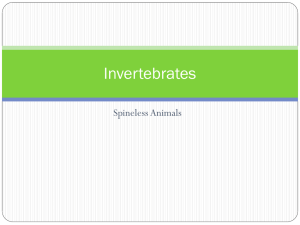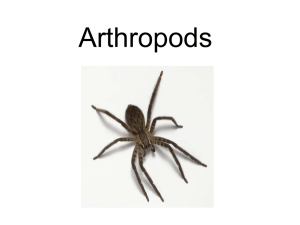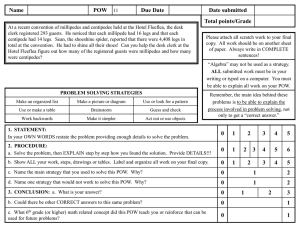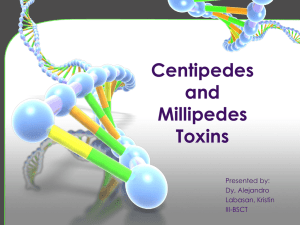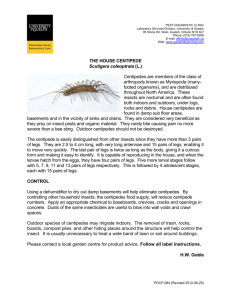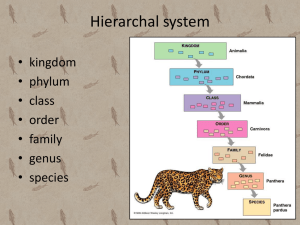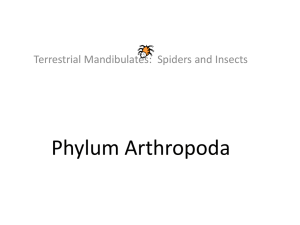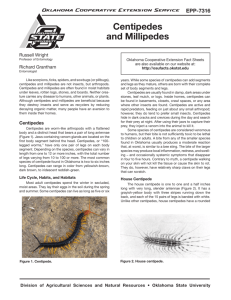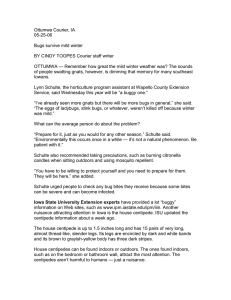M Millipedes & Centipedes
advertisement
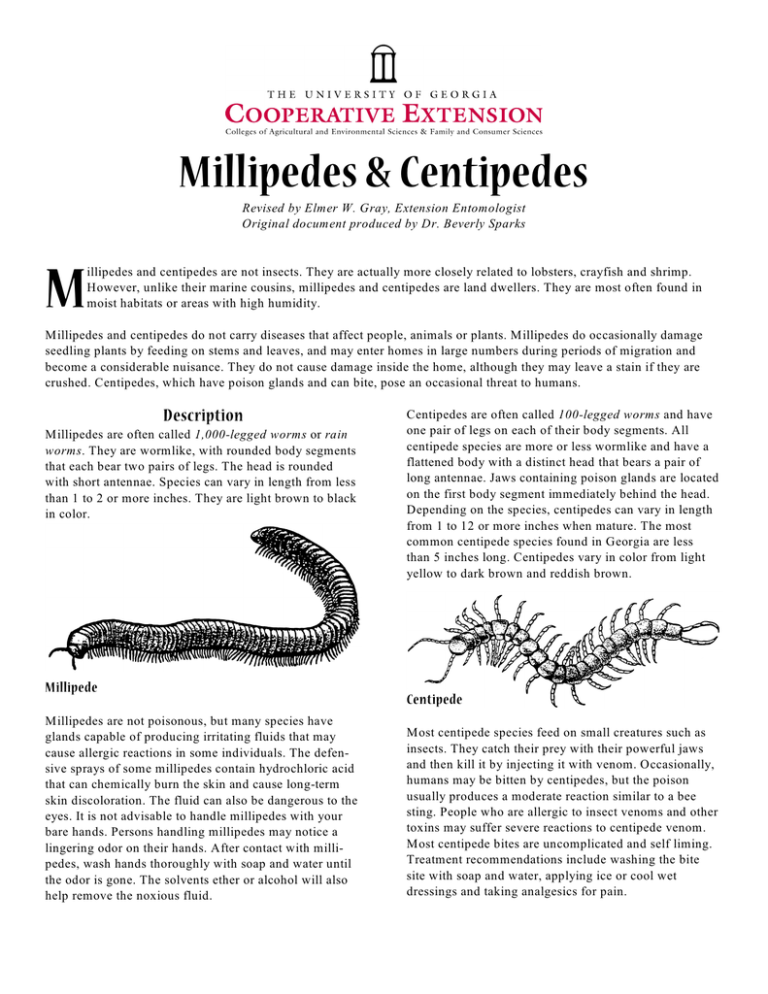
Millipedes & Centipedes Revised by Elmer W. Gray, Extension Entomologist Original document produced by Dr. Beverly Sparks M illipedes and centipedes are not insects. They are actually more closely related to lobsters, crayfish and shrimp. However, unlike their marine cousins, millipedes and centipedes are land dwellers. They are most often found in moist habitats or areas with high humidity. Millipedes and centipedes do not carry diseases that affect people, animals or plants. Millipedes do occasionally damage seedling plants by feeding on stems and leaves, and may enter homes in large numbers during periods of migration and become a considerable nuisance. They do not cause damage inside the home, although they may leave a stain if they are crushed. Centipedes, which have poison glands and can bite, pose an occasional threat to humans. Description Millipedes are often called 1,000-legged worms or rain worms. They are wormlike, with rounded body segments that each bear two pairs of legs. The head is rounded with short antennae. Species can vary in length from less than 1 to 2 or more inches. They are light brown to black in color. Millipede Millipedes are not poisonous, but many species have glands capable of producing irritating fluids that may cause allergic reactions in some individuals. The defensive sprays of some millipedes contain hydrochloric acid that can chemically burn the skin and cause long-term skin discoloration. The fluid can also be dangerous to the eyes. It is not advisable to handle millipedes with your bare hands. Persons handling millipedes may notice a lingering odor on their hands. After contact with millipedes, wash hands thoroughly with soap and water until the odor is gone. The solvents ether or alcohol will also help remove the noxious fluid. Centipedes are often called 100-legged worms and have one pair of legs on each of their body segments. All centipede species are more or less wormlike and have a flattened body with a distinct head that bears a pair of long antennae. Jaws containing poison glands are located on the first body segment immediately behind the head. Depending on the species, centipedes can vary in length from 1 to 12 or more inches when mature. The most common centipede species found in Georgia are less than 5 inches long. Centipedes vary in color from light yellow to dark brown and reddish brown. Centipede Most centipede species feed on small creatures such as insects. They catch their prey with their powerful jaws and then kill it by injecting it with venom. Occasionally, humans may be bitten by centipedes, but the poison usually produces a moderate reaction similar to a bee sting. People who are allergic to insect venoms and other toxins may suffer severe reactions to centipede venom. Most centipede bites are uncomplicated and self liming. Treatment recommendations include washing the bite site with soap and water, applying ice or cool wet dressings and taking analgesics for pain. Life Cycle and Habits Control Most millipedes are scavengers and feed primarily on decaying vegetation and leaf litter, although some species attack roots of living plants. Millipedes spend most of their lives in the soil where they also overwinter. In the spring, millipedes lay between 20 and 300 eggs in the soil. The eggs hatch in several weeks. Young millipedes have only the first three pairs of legs and no more than seven segments. With each molt, they add additional segments and legs until they reach sexual maturity — usually in two to five years, depending on the species. The first and most important step in controlling millipedes and centipedes is removing or eliminating objects that provide hiding places for the pest outside the home. Eliminate trash piles, rocks, boards, leaf piles, compost piles and similar materials from the immediate vicinity around the outside of the home. Secondly, physically exclude millipedes and centipedes from entering the home where possible. Make sure doors and windows fit tightly and caulk cracks and crevices that permit their entry to the inside. If millipedes or centipedes occur in great numbers or are creating problems, applying pesticide around the building foundation and around doors and windows will provide temporary control. Refer to the current Georgia Pest Management Handbook for the latest recommendations concerning insecticides and pesticides. Centipedes are found in a variety of habitats, but prefer dark, moist, protected areas such as under stones, rotted logs, leaves and bark. They overwinter as adults and lay eggs in the soil during the spring and summer. Development is slow, with some species developing through as many as 10 instars, or molts. A few species give birth to living young. Centipedes are relatively long-lived; some species have been known to live up to six years. House Centipede The house centipede, Scutigera coleoptrata, is the only species capable of reproducing in homes and is often seen in and around homes where dampness occurs. The house centipede is active at night, moving about in search of cockroaches and other insects. Although centipedes rarely bite, are seldom dangerous and are beneficial because they destroy other insects, most people have an aversion to their presence inside their homes. Pesticide may also be applied to mulched flower beds and heavily thatched turf areas where millipedes may be living. Include these areas in a treatment program during periods when millipedes are found inside the home in large numbers. Repeated applications may be necessary to maintain control during periods of heavy millipede migration. Use products approved for in-home use to treat cracks and crevices along baseboards and other areas where centipedes and millipedes may hide. Contact sprays may be applied directly to millipedes and centipedes for quick control when they are found inside the home. Follow all pesticide label instructions closely for safe and effective use, particularly in the home. The University of Georgia and Ft. Valley State University, the U.S. Department of Agriculture and counties of the state cooperating. Cooperative Extension, the University of Georgia College of Agricultural and Environmental Sciences, offers educational programs, assistance and materials to all people without regard to race, color, national origin, age, gender or disability. An Equal Opportunity Employer/Affirmative Action Organization Committed to a Diverse Work Force B 1088 Revised January 2009
